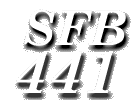
Project B8:
Corpusbased analysis of local and temporal deictics in (spontaneously)
spoken and (reflected) written language
(discontinued since 2002)
|
||
|
||
|
||
|
Head of the project
Prof. Dr. Jochen RaeckeSlavic seminar
University of Tübingen
Wilhelmstraße 50
72074 Tübingen
Phone: +49/7071/29-75027; Fax +49/7071/29-5924
Email: jochen.raecke@uni-tuebingen.de
Staff
- Slavica Stevanović
- Office: Nauklerstr.35, Room 2.11
- Phone: +49/7071/29-77150
- Email: slavica.stevanovic@uni-tuebingen.de
-
- Gabrijela Fulir
- Office: Nauklerstr. 35, Room 2.11
- Phone: +49/7071/29-77150
- Email: gabi.fulir@student.uni-tuebingen.de
The Aim of the Project
The subject of the project are all those units of words within the Bosnian/Croatian/Serbian language that formally build a homogenious class ([almost complete] similar bases with [almost complete] derivative formatives) and are traditionally considered to be units of a three-level personrelated deixis, i. e. related to the speaker, the contacted person and the discussed topic. There is no doubt that these units belong together in a functional way because they can be used as demonstratives and therefore can function in the indisputable essence of deixis. Therefore it is only correct to see them as a morphological class. But already the dictionairies of Vuk Karadžić (1818, 1852) and others, which were published later, and predominantly the researches, which have been made on the basis of more voluminous texts that build the parts of a continuously broadened, partially self-gatherd and partially taken-over corpus, let us suspect that these units are not only representatives of a three-level personcentered deixis. The project questions, in accordance with this suspection, two claims: the first one questions the three-level distinction that is anticipated in the form of the units, and the second one asks if the interpretation of these units as exclusively personcentered is to be seen in their real usage and whether this can linguistically be justified. The corpus, that engrows our doubts, includes various texts, literary and non literary ones (televisionnews, newspaper-texts, comics, interviews, academic publications) and (not edited) spontaneously spoken language (narrativinterviews). It is exactly the comparative analysis of such heterogeneous texts that should show the necessity of an extensive revision of the idea about the deictics as systematically three-level distincted and exclusively personcentered. This analysis points out that the connection between the form and the function of these units with strong semantic/syntactic/pragmatic specialisations is - if it has ever existed this way - in the meanwhile abundant broken off. These deictics, or rather those of them, which are still common nowadays, still build a functional class, but no more a heterogeneosly or systematically structured one. Relevant and recurrent differences are to be established particularly between the texts that can be described as documents of, on the one hand, reflected written, and on the other hand, spontaneosly spoken language. Equivalent analyses that are - deviating from custom - neither inclined to confirm one, explicit or implicit, beforehand given deictics system, nor limited to the discussion of the chosen examples, but observe all the appropriate dates which are contained in the corpus as principally equal units, allow us already by this time to consolidate that: 1) there is a significant medial distinction in the usage of single units, concerning both the inventory and their frequency, which means that both the two "systems" - the written language and the spontaneously spoken language - and the functions of the "same" units are different in the two media; this leads us to assume a change that in the spontaneosly spoken language partially already took and partially still takes place; 2) the two-level distinction has partially taken place of the three-level and the person- relation is subjected to restrictions, so that this relation is to be seen as neither a general nor as the only one; and 3) the phenomenon of these deictics, or the deictics in general, is that they depend on the sort of the text much more as it has been - if it has at all (Diewald 1991, Green 1995) - perceived by the research. The aim of the project is to bring the theoretical description and the language reality of the v/t/n-deictics, by means of an extensivelly PC-supported dataexploration, closer together as it is evident at the moment.
Publications
Created by Laura Kallmeyer and Christoph Singer. Last modified 17 September 2001
Contact: Slavica Stevanović.
